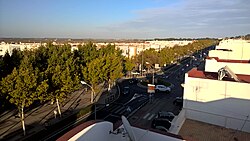You can help expand this article with text translated from the corresponding article in Spanish. (December 2009)Click [show] for important translation instructions.
|
Isla Cristina, Spain | |
|---|---|
 | |
 Location of Isla Cristina | |
| Municipality | Huelva |
| Government | |
| • Mayor | María Luisa Faneca |
| Area | |
• Total | 50 km2 (19 sq mi) |
| • Land | 50 km2 (19 sq mi) |
| • Water | 0.00 km2 (0 sq mi) |
| Population (2024-01-01) [1] | |
• Total | 21,641 |
| • Density | 430/km2 (1,100/sq mi) |
| Time zone | UTC+1 (CET) |
| • Summer (DST) | UTC+2 (CEST) |
| Website | |

Isla Cristina is a city and municipality located in the province of Huelva, Spain, close to the Portuguese border. According to the 2009 census, the city has a population of 21,324 inhabitants.
Contents
Isla Cristina remains one of the most important fishing ports in Andalusia, its catch being highly prized throughout Spain.
It is a popular summer holiday resort, particularly with the Spaniards themselves. Sevillanos flock to the area in July and August, much of the attraction being the kilometers of 'Blue Flag' standard beaches.


